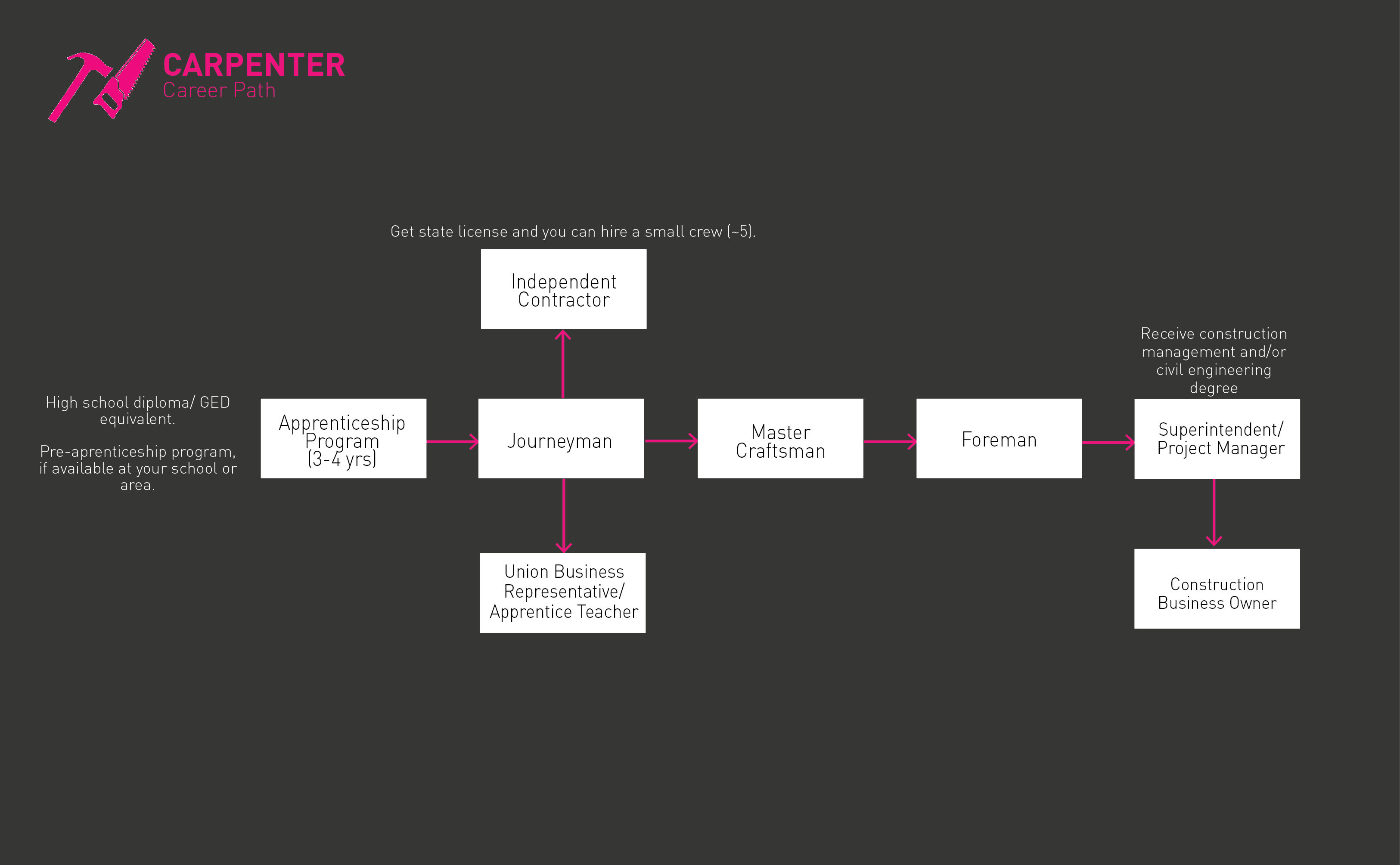Mga spotlight
Karpintero ng Tulay, Gumagawa ng Gabinete, Karpintero, Karpintero ng Konkreto, Karpintero sa Konstruksyon, Karpintero ng Anyo, Framer, Karpintero sa Pagpapanatili, Magaspang na Karpintero, Tagabuo ng plantsa
Ang mga karpintero ay nagtatayo at nagkukumpuni ng mga balangkas at istruktura ng gusali na gawa sa kahoy at iba pang materyales.
- Makakagawa ka ng mga bagay at magtrabaho gamit ang iyong mga kamay!
- Mobility : Kung ikaw ay nasa unyon, mayroong iba't ibang lokal na club sa buong bansa. Kaya kung lilipat ka sa ibang lungsod, maaari kang makapasok sa listahan ng Out of Work at matawagan para sa trabaho.
- Flexibility : Ikaw ang magpapasya kung gaano mo gustong magtrabaho. Gumawa ka ng sarili mong bakasyon. Walang 2 linggong bakasyon.
“Nakakapag-iba ka ng tingin sa mundo. Alam mo kung paano gumawa ng mga bagay, magdisenyo ng mga bagay, gumawa ng mga bagay...Nang binili ko ang aking bahay, binago ko ang disenyo ng sarili kong banyo. Pakiramdam mo ay may kapangyarihan ka. Maaari kang lumikha at bumuo sa isang regular na batayan." Silvia Y. Ledezma, Journeyman Carpenter, Scaffold (Staging) Builder, Contra Costa County
- Sumusunod sa mga blueprint at mga plano sa pagbuo upang matugunan ang mga pangangailangan ng mga kliyente.
- Nag-i-install ng mga istruktura at fixture, tulad ng mga bintana at paghubog.
- Mga sukat, hiwa, o hugis ng kahoy, plastik, fiberglass, drywall, at iba pang mga materyales.
- Bumubuo ng mga balangkas ng gusali, kabilang ang mga wall stud, joists sa sahig, at mga doorframe.
- Tumutulong sa paglalagay, pag-level, at pag-install ng balangkas ng gusali sa tulong ng malalaking pulley at crane.
- Sinusuri at pinapalitan ang nasirang balangkas o iba pang istruktura at mga kabit.
- Nagtuturo at namamahala sa mga manggagawa at iba pang mga katulong sa kalakalan sa konstruksiyon.
Residential
- Gumagana sa bagong-bahay, townhome, at condominium construction at remodeling.
- Mga halimbawang gawain : Bumubuo at nagtatakda ng mga form para sa mga footing, dingding, bubong at deck; Kino-frame ang mga panloob na dingding, gumagawa ng mga hagdan, at nag-i-install ng drywall, paghuhulma ng korona, mga pinto at mga cabinet sa kusina.
Komersyal
- Gumagana sa komersyal na gusali ng opisina, mga ospital, mga hotel, mga paaralan at mga shopping mall na konstruksyon at remodeling.
- Mga halimbawang gawain : Gumagana sa light gauge at load-bearing steel framing para sa interior partition, exterior framing, at curtain wall construction.
- Karaniwang magagawa rin ng mga komersyal na karpintero ang mga gawain ng mga residential na karpintero.
Pang-industriya
- Gumagana sa mga setting ng sibil at pang-industriya kung saan naglalagay sila ng scaffolding at nagtatayo at nagtatakda ng mga form para sa pagbuhos ng kongkreto. Halimbawa) mga tunnel, tulay, power plant, o mga proyekto sa pagtatayo ng sewer.
- Mga halimbawang gawain : Bumubuo ng tunnel bracing o mga partisyon sa mga daanan at minahan sa ilalim ng lupa upang kontrolin ang sirkulasyon ng hangin sa mga lugar ng trabaho.
- Manu-manong kagalingan ng kamay : mahusay sa mga kamay
- Koordinasyon ng mata ng kamay
- Kritikal na pag-iisip at paglutas ng problema : makakatagpo ng mga hindi inaasahang problema at kakailanganin mong malaman ang mga ito sa isang napapanahong paraan.
- Basic math : arithmetic, algebra, geometry, calculus at statistics.
- Mga kasanayan sa kompyuter : pagpaplano ng proyekto, pagtatantya ng software.
- Pansin sa detalye
- Lakas at tibay ng katawan
- Maaaring mapanganib dahil nagtatrabaho ka sa mga matutulis na bagay at sa matataas na lugar.
- Walang istraktura : kailangan mong pamahalaan ang iyong pera at oras dahil ang trabaho ay batay sa proyekto. Natapos mo ang isang proyekto at maaaring tumagal ng ilang oras kapag nakakuha ka ng isa pang proyekto. Kailangang pamahalaan ang iyong oras at pananalapi nang matalino.
- Kung gusto mo ang istraktura at gusto ang 2-linggong suweldo, hindi ito ang trabaho para sa iyo. Ngunit kung gusto mo ng kakayahang umangkop, upang itakda ang iyong sariling mga oras, kung gayon ito ay isang mahusay na landas sa karera.
- Pagbuo, paglikha at pag-aayos ng mga bagay!
- Ang pagiging nasa labas sa kalikasan.
"Ako ay naging pintor mula noong ako ay 17 taong gulang at palagi kong nagustuhan ang pagtatrabaho gamit ang aking mga kamay - paggupit, pagbanig." Silvia Y. Ledezma, Journeyman Carpenter, Scaffold (Staging) Builder, Contra Costa County
- Proteksyon : sahod, diskriminasyon, pinsala sa trabaho.
- Wala sa listahan ng trabaho
- Benepisyo
- Mas mataas na suweldo: over-time, double time.
- Pagreretiro (depende sa unyon): Pagkatapos ng 5 taon, sa ilang mga trades/unions, ikaw ay nakatalaga at karapat-dapat para sa pagtutugma ng kumpanya. Pagkatapos ng 30 taon, ganap kang binigay sa 100 porsiyento ng iyong suweldo.
- Natututo ang mga karpintero ng kanilang pangangalakal sa pamamagitan ng pag-aaral at pagsasanay. Ang isang diploma sa high school/GED ay kailangan, ngunit ang isang degree sa kolehiyo ay hindi
- Ang ilang mga mag-aaral ay kumukumpleto ng isang associate sa pagkakarpintero mula sa isang community college o vocational school
- Ang mga asosasyon ng unyon at kontratista ay namamahala ng mga kaugnay na programa sa pag-aprentis (tingnan ang aming Mga Inirerekomendang Mapagkukunan > Mga Website para sa mga detalye)
- Ang praktikal na edukasyon na nakuha mula sa karanasan sa trabaho ay mahalaga. Ang mga karpintero sa paunang antas ay nagsisimula sa mga pangunahing gawain, na nag-aaral sa ilalim ng pangangasiwa ng isang batikang propesyonal
- Kasama sa mga karaniwang bahagi ng pag-aaral ang pagbabasa ng mga blueprint, pangunahing matematika, mga code ng gusali, mga prinsipyo sa kaligtasan, at first aid
- Kinakailangan din ang pangunahing pagsasanay sa kaligtasan ng Occupational Safety and Health Administration (OSHA).
- Ang karagdagang espesyal na pagsasanay ay maaaring sumaklaw sa pagtatrabaho sa kongkreto, welding, rigging at scaffolding, at mga protocol na nakakulong sa espasyo
- Mayroong dose-dosenang mga espesyal na opsyon sa sertipikasyon mula sa mga organisasyon tulad ng:
- Pinto at Hardware Institute
- Fenestration at Glazing Industry Alliance
- Green Business Certification Inc.
- Pambansang Samahan ng mga Tagabuo ng Tahanan
- National Association of the Remodeling Industry
- Pambansang Sentro para sa Edukasyon at Pananaliksik sa Konstruksyon
- National Wood Flooring Association
- Scaffold at Access Industry Association
- Vinyl Siding Institute
- Pinakamababang edad na 18
- Edukasyon sa mataas na paaralan o katumbas
- Pisikal na kayang gawin ang trabaho
- mamamayan ng US o patunay ng legal na paninirahan
- Ipasa ang pagsusuri sa pag-abuso sa sangkap
Mag-click dito upang mahanap ang iyong lokal na apprentice training center.
- Kumuha ng mga kurso sa high school tulad ng shop, math, algebra, geometry, physics, at mechanical drawing
- Ugaliing magsanay ng mabuting kaligtasan at magsuot ng wastong personal na kagamitan sa proteksyon
- Kung kinakailangan, magsimula ng isang programa sa pag-eehersisyo o kumuha ng PE upang matiyak na mayroon kang kinakailangang lakas at tibay upang magsagawa ng gawaing karpintero nang buong-panahon.
- Kunin ang iyong lisensya sa pagmamaneho upang makapunta ka sa mga lugar ng trabaho kung kinakailangan
- Mag-apply sa entry-level na mga trabaho sa construction laborer upang makakuha ng real-world na karanasan
- Magboluntaryo sa mga lokal na proyekto sa pagtatayo ng Habitat for Humanity para malaman ang tungkol sa mga materyales, pamamaraan, at kasangkapan. Isaalang-alang ang mga pagkakataon sa ibang bansa para sa dagdag na kaguluhan!
- Suriin ang mga pamantayan para sa pagkuha ng isang Carpenter apprenticeship sa iyong lugar
- Pag-aralan ang mga aklat, artikulo, at video tutorial na nauugnay sa kalakalan
- Magtanong sa isang batikang Carpenter kung maaari ka nilang turuan
- Panatilihin ang isang gumaganang draft ng iyong resume, tandaan ang anumang mga kasanayang nakuha mo, mga proyektong natapos, at iba pang mga detalye
- Magpa-certify sa isang espesyal na lugar para palakasin ang iyong mga kredensyal
- 43.4 % na may HS Diploma
- 5.1 % sa Associate's
- 6.1 % na may Bachelor's
- 0.9 % na may Master's
- 0.3 % sa Propesyonal

- Ang mga apprenticeship ng karpintero ay ang paraan upang makapasok sa linyang ito ng trabaho
- I-screen ang mga ad ng trabaho sa mga portal ng trabaho gaya ng Indeed, Simply Hired, Glassdoor, at Zippia, pati na rin ang Craigslist para sa mas maliliit, lokal na pagkakataon
- Basahing mabuti ang mga kinakailangan at tiyaking natutugunan mo ang lahat ng kinakailangang pamantayan
- Makipag-ugnayan sa iyong network upang ipaalam sa lahat na naghahanap ka ng trabaho
- Bisitahin ang mga website ng mga lokal na kumpanya na kumukuha ng mga Carpenters. Maghanap ng mga bakanteng trabaho na maaaring hindi nakalista sa ibang lugar
- Maging maagap! Pag-isipang tumawag sa ilang kumpanya para magtanong tungkol sa mga apprenticeship
- Kung nag-aaral sa isang kolehiyo o trade school, humingi ng tulong sa kanilang career center sa pagbuo ng resume at pagsasanay para sa mga panayam
- Maraming mga trade/vocational program ang nagsisilbing pipeline sa mga lokal na recruiter, kaya ipaalam sa kanila kapag handa ka na para sa trabaho!
- Suriin ang mga template ng resume ng Carpenter upang makakuha ng mga ideya para sa mga salita at mga format
- Dumalo sa mga lokal na job fair para makipag-usap sa mga recruiter at ibahagi ang iyong resume
- Makipag-usap sa iyong mga guro at dating superbisor tungkol sa kanilang pagpayag na magsilbi bilang mga personal na sanggunian
- Pag-aralan ang mga tanong sa panayam ng Carpenter para maghanda para sa mga panayam!
- Hustle !: Huwag lamang umasa sa wala sa listahan ng trabaho. Dumalo sa mga lokal na kaganapan ng unyon. Gumawa ng mga relasyon sa foreman. Maging maagap.
- Makipag-usap sa iyong koponan.
- Maging mausisa at patuloy na matutunan ang mga bagong pag-unlad (software, diskarte, balita) ng karera.
- Mga kasanayan sa wika: Ang kaalaman sa Espanyol ay isang malaking plus.
Mga website
- Apprenticeship.gov
- Mga Kaugnay na Tagabuo at Kontratista
- Mga Kaugnay na Pangkalahatang Kontratista ng Amerika
- CareerOneStop
- Department of Labor Employment and Training Administration
- Pinto at Hardware Institute
- Fenestration at Glazing Industry Alliance
- Green Business Certification Inc.
- Mga helmet sa Hardhats
- Home Builders Institute
- Pambansang Samahan ng mga Tagabuo ng Tahanan
- National Association of the Remodeling Industry
- National Building Trades Union
- Pambansang Sentro para sa Edukasyon at Pananaliksik sa Konstruksyon
- National Wood Flooring Association
- NCCER
- Pangangasiwa sa Kaligtasan at Kalusugan sa Trabaho
- Scaffold at Access Industry Association
- Nagkakaisang Kapatiran ng mga Karpintero
- Vinyl Siding Institute
Mga libro
- Modern Carpentry Workbook, ni Willis H. Wagner, Howard Bud Smith, et al.
- The Very Efficient Carpenter: Basic Framing for Residential Construction, ni Larry Haun
- Mga Plano at Proyekto sa Woodworking: Ang Step-by-Step na Gabay, ni Anthony Deck
Newsfeed

Mga Tampok na Trabaho

Mga Online na Kurso at Tool

Mga Inaasahan sa Taunang Sahod
New workers start around $52K. Median pay is $66K per year. Highly experienced workers can earn around $85K.






